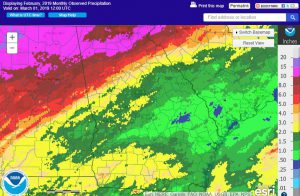Warmer than normal temperatures covered Georgia again in February 2019, with values ranging from five to nine degrees F above average. Heavy rainfall covered the northern quarter of the state, while precipitation two to four inches less than normal covered the rest of the state.
In Atlanta, the monthly average temperature was 53.8 degrees F (6.6 degrees above normal), in Athens 52.2 degrees F (5.0 degrees above normal), Columbus 58.7 F (7.6 degrees above normal), Macon 55.8 F (5.8 above normal), Savannah 60.4 F (7.4 above normal), Brunswick 62.1 F (7.6 above normal), Alma 61.3 F (7.1 above normal), Augusta 55.8 F (6.7 above normal), Albany 61.6 F (9.2 above normal), Rome 51.6 F (7.3 above normal), and Valdosta 61.7 F (7.5 degrees above normal).
Almost every station in the state set at least one new daily high temperature record during February. On February 7, temperatures far above normal led to records in Atlanta (80 F, breaking the old record of 72 F set in 1937), Athens (81 F, beating the old record of 76 set in 1927), Macon (81 F, breaking the old record of 79 F set in 1999), Augusta (85 F, compared to 80 F set in 2017), and Alma (82 F, one degree higher than the previous record set in 1957). High temperature records were also tied on that date in Savannah and Columbus. The high temperature record was also broken in Savannah on February 22, with 86 F surpassing the old record of 83 F set in 2018.
The Atlanta airport did not report a single day below freezing in February. The only other February that did not get below freezing in Atlanta in their 141-year record was 1957.
The highest monthly total precipitation from National Weather Service reporting stations was 10.83 inches in Rome (5.96 inches above normal) and the lowest was in Savannah with 0.89 inches (1.90 inches below normal). Atlanta received 4.14 inches (0.53 inches below normal), Athens received 3.66 inches (0.87 below normal), Columbus received 1.50 inches (2.94 below normal), Macon 1.37 inches (2.99 below normal), Augusta 1.14 inches (2.78 below normal), Alma 1.64 inches (2.16 below normal), Brunswick 2.14 inches (1.33 below normal), Valdosta 2.01 inches (2.15 below normal), and Albany 1.71 inches (2.45 inches below normal).
No daily rainfall records were reported in February at the major NWS observing sites in the state.
The highest daily rainfall total from CoCoRaHS observers was 2.90 inches observed near Dawsonville in Dawson County on February 21, followed by 2.69 inches measured at Kennesaw in Cobb County and 2.65 inches observed near Dillard in Rabun County on the same date. For the month, an observer near Dahlonega in Lumpkin County reported a total of 13.73 inches, followed by 13.37 inches from the Dawsonville observer and 13.22 inches in Sautee in White County.
No snowfall was reported this month.
Two tornadoes occurred in Georgia in February. On February 12 a tornado touched down near Lake City in Clayton County, causing a large tree to fall and damage a home, and on February 23 an EF-1 tornado hit near Moreland in Coweta County, causing damage to many trees. A number of wind damage reports were also made on February 12, and numerous flood reports were listed on February 22.
There was no drought in Georgia in February 2019, but by the end of the month a small area of abnormally dry conditions was introduced to the east central part of the state along with a sliver of drought near Tybee Island near Savannah.
Livestock producers, field crops, fruit and vegetable growers all noted negative impacts from the wet conditions across the state, especially in northern areas where the rain was the heaviest. The warm and moist conditions have led to early bloom of some fruit species, which could result in damage if frost returns in March. Many cattle producers are feeding hay because of poor quality of forage due to the rain. Rain caused flooding of pastures in northern counties. Harvesting of cotton and peanuts was finally nearly completed by the end of the month, with some fields abandoned without harvesting due to poor yields and bad conditions in some crops due to the problems with excess moisture. By the end of the month planting was occurring in some southern counties.
The outlook for March shows that most of the state is in equal chances of below, near or above normal, with the exception of the southern third of the state, which leans slightly towards warmer than normal temperatures. Wet conditions are expected to continue for most of the month. The March through May outlook leans slightly towards warmer and wetter than normal for the entire state.
For more information please see the “Climate and Agriculture” blog at https://site.extension.uga.edu/climate/. You can also visit the University of Georgia weather network web page at https://www.georgiaweather.net. Please feel free to email your weather and climate impacts on agriculture to share on the blog to pknox@uga.edu.


